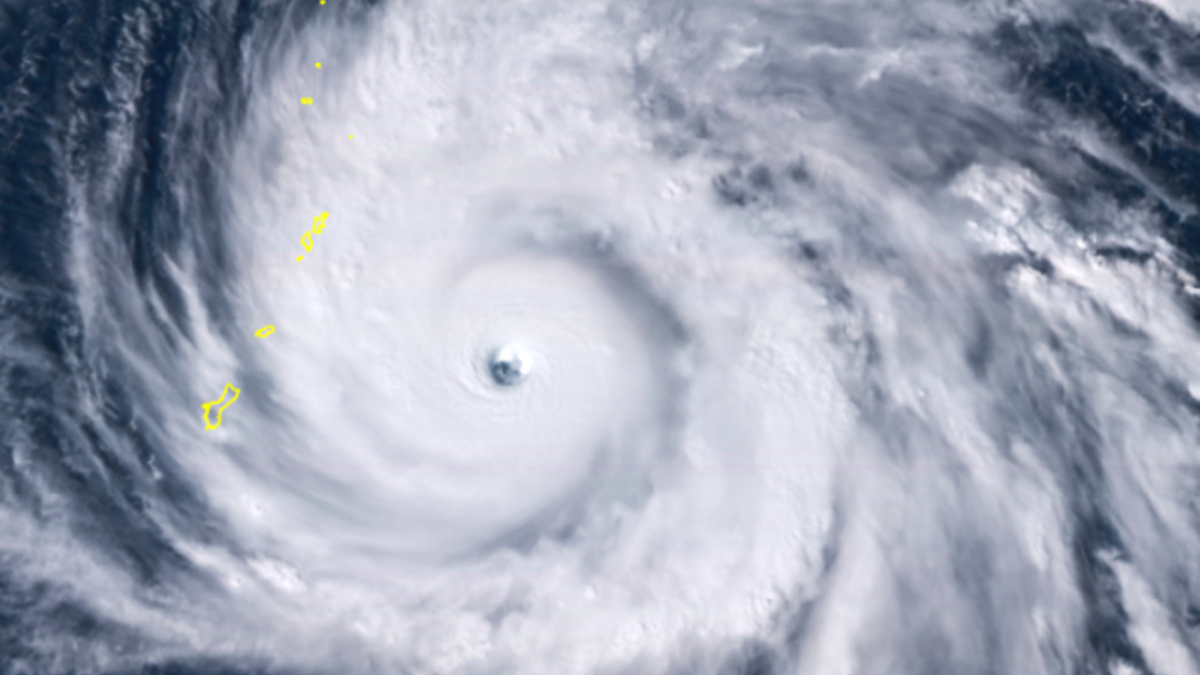
This satellite image provided by the National Oceanic and Atmospheric Administration (NOAA) shows Typhoon Yutu east of Guam Wednesday afternoon, Oct. 24, 2018 local time. The storm crossed over the U.S. Commonwealth of the Northern Mariana Islands, producing damaging winds and high surf. The National Weather Service in Honolulu says maximum sustained winds of 180 mph (290 kph) were recorded around the eye of the storm, which passed over Tinian island and Saipan early Thursday morning local time. Waves of 25 to 40 feet (6 to 12 meters) are expected around the eye of the storm. (NOAA via AP)
HONOLULU – Super Typhoon Yutu crossed over the U.S. commonwealth of the Northern Mariana Islands early Thursday as the equivalent of a category 5 hurricane, making it the strongest storm to hit any part of the U.S. this year, the National Weather Service said.
"At its peak, it felt like many trains running constant," Glen Hunter wrote in a Facebook message to The Associated Press. Hunter lives on Saipan, the largest island in the commonwealth, which is a U.S. territory about 3,800 miles (6,115 kilometers) west of Hawaii.
"At its peak, the wind was constant and the sound horrifying," he said.
Maximum sustained winds of 180 mph (290 kph) were recorded around the eye of the storm, which passed over Tinian and Saipan early Thursday local time, said Brandon Aydlett, a meteorologist with the National Weather Service.
There were no immediate reports of deaths or injuries.
Tinian suffered a direct hit. Saipan and Tinian will be unrecognizable, Aydlett said, adding that the weather service received reports that Yutu's catastrophic winds ripped roofs from homes and blew out windows.
"Any debris becomes shrapnel and deadly," he said.
Fallen trees could isolate residents, and power and water outages could last weeks, the weather service warned.
"Gonna be quite a scene when the sun comes up," Hunter wrote to the AP early Thursday.
It was still quite dark when he peeked outside and saw his neighbor's house, made of wood and tin, completely gone. A palm tree was uprooted.
Hunter, 45, has lived on Saipan since childhood and is accustomed to strong storms. "We are in typhoon alley," he wrote, but added this is the worst he has experienced.
Power went out the previous afternoon, and Hunter was bracing for months without electricity or running water. All government offices and schools shut down two days ago. A few gas stations ran out of gas by Tuesday evening, he said.
"We knew it was going to be big," he said, "but wow."
The roof flew off the second floor of Del Benson's Saipan home.
"We didn't sleep much," he wrote to the AP in a Facebook message. "I went upstairs and the skylight blew out. Then the roof started to go. We got the kids downstairs."
Recovery efforts on Saipan and Tinian will be slow, Aydlett said. "This is the worst-case scenario. This is why the building codes in the Marianas are so tough," he said. "This is going to be the storm which sets the scale for which future storms are compared to."
Nearly 200 federal workers were in the Marianas to assist, Gregorio Kilili Camacho Sablan, the commonwealth's delegate to U.S. Congress, said on Twitter.
Six of Saipan's 10 shelters were full, he wrote, and Tinian's shelter was full.
All ports were closed, and flights into the Northern Marianas were canceled, he wrote.
"The Tinian Medical Center sustained extensive damage. Fortunately no patients were present," he wrote in a post that also said the Commonwealth Healthcare Center and Rota Medical Center were running on generator power.
The emergency operations center was having phone connectivity issues, Sablan tweeted later in the day. Cellphone and landline service was spotty in Saipan.
Dean Sensui, vice chair for Hawaii on the Western Pacific Regional Fishery Management Council, was in Saipan for a council meeting. He hunkered down in his hotel room, where guests were told to remain indoors because winds were still strong Thursday morning.
"From around midnight the wind could be heard whipping by," he said in a Facebook message. "Down at the restaurant it sounded like a Hollywood soundtrack with the intense rain and howling wind."
Because he's in a solid hotel, it wasn't as scary as living through Hurricane Iniki in 1992, which left the Hawaiian island of Kauai badly damaged, he said. "The fact that we still have Internet access proves how solid their infrastructure is," he said. "Hawaii and others should study the Marianas to understand how to design and build communication grids that can withstand a storm."
The Northern Marianas have a population of about 55,000 people.
Waves of 25 to 40 feet (6 to 12 meters) were expected around the eye of the storm, and flooding is likely, forecasters said.
A typhoon warning was in effect for Saipan, Tinian and Rota. A tropical storm warning was in place for Guam and other southern islands.

